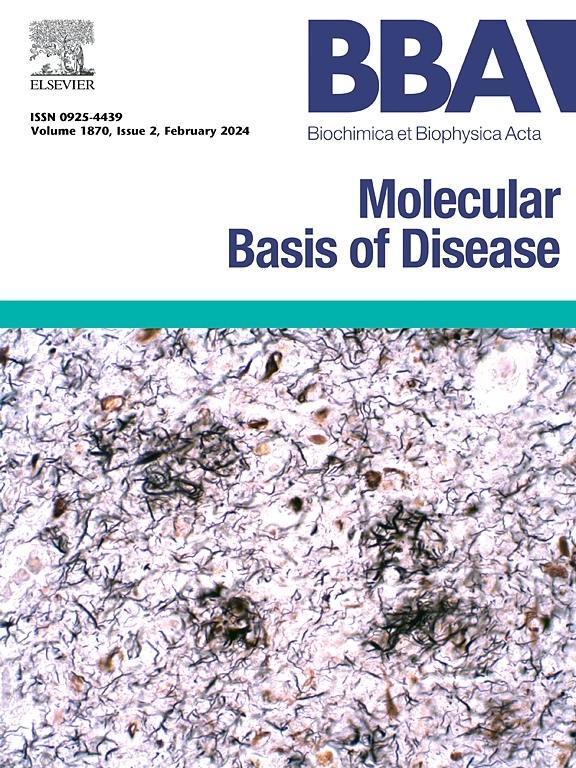揭示m6A甲基化在SLC22A3表达中对乳腺癌干预的保护作用
IF 4.2
2区 生物学
Q2 BIOCHEMISTRY & MOLECULAR BIOLOGY
Biochimica et biophysica acta. Molecular basis of disease
Pub Date : 2025-06-24
DOI:10.1016/j.bbadis.2025.167962
引用次数: 0
摘要
SLC22A3表达与m6A RNA甲基化之间的相互作用正在成为乳腺癌病理的一个重要因素,但具体的相关性和潜在的机制尚不清楚。方法利用肿瘤基因组图谱(cancer Genome Atlas)数据评估SLC22A3表达在乳腺癌中的预后意义。体外实验使用定制设计的dCas13b-METTL3质粒进行,旨在选择性地增强SLC22A3 mRNA的m6A甲基化。对转染后乳腺癌细胞的功能改变进行了评估。此外,我们还实现了m6A读取器蛋白IGF2BP2的过表达,并分析了SLC22A3表达和整体乳腺癌细胞转录组的变化。采用MeRIP-seq和mRNA-seq分析Slc22a3在乳腺癌转基因小鼠模型中的表达和m6A甲基化情况。结果生物信息学分析显示,SLC22A3在癌组织中的表达明显低于癌旁非癌组织。通过dCas13b-M3质粒增强乳腺癌细胞中SLC22A3 mRNA m6A甲基化,导致SLC22A3表达增加,同时细胞增殖和迁移减少,诱导凋亡。IGF2BP2过表达同样增加了SLC22A3的表达。此外,RNA-seq鉴定了SLC22A3下游的25个基因。对小鼠乳腺癌组织的分析显示,随着乳腺癌的进展,SLC22A3的表达及其m6A甲基化都有所下降。结论slc22a3在乳腺癌中起保护作用。SLC22A3 mRNA的m6A甲基化增强和m6A读取器IGF2BP2的过表达上调了其表达。通过m6A CRISPR方法诱导SLC22A3 mRNA甲基化,有效减轻乳腺癌细胞的恶性。本文章由计算机程序翻译,如有差异,请以英文原文为准。

Unraveling the protective role of m6A methylation in SLC22A3 expression for breast Cancer intervention
Background
The interplay between SLC22A3 expression and m6A RNA methylation is emerging as a significant factor in breast cancer pathology, yet the specific correlations and underlying mechanisms remain unclear.
Methods
The prognostic significance of SLC22A3 expression in breast cancer was assessed using the Cancer Genome Atlas data. In vitro experiments were conducted using a custom-engineered dCas13b-METTL3 plasmid, designed to selectively enhance m6A methylation of SLC22A3 mRNA. Functional alterations in breast cancer cells post-transfection were evaluated. Additionally, overexpression of the m6A reader protein IGF2BP2 was achieved, and subsequent changes in SLC22A3 expression and overall breast cancer cell transcriptome were analyzed. MeRIP-seq and mRNA-seq were employed to analyze the expression and m6A methylation of Slc22a3 in a transgenic mouse model of breast cancer.
Results
Bioinformatics analysis demonstrated a significant reduction in SLC22A3 expression in cancer tissues compared to adjacent non-cancerous tissues. Enhancement of SLC22A3 mRNA m6A methylation via the dCas13b-M3 plasmid in breast cancer cells led to increased SLC22A3 expression, accompanied by reduced cell proliferation and migration and induced apoptosis. Overexpression of IGF2BP2 similarly increased SLC22A3 expression. Further, RNA-seq identified 25 genes downstream of SLC22A3. Analysis of breast cancer tissues from mice revealed a decrease in both SLC22A3 expression and its m6A methylation as the breast cancer progressed.
Conclusion
SLC22A3 acts as protective factor in breast cancer. Enhanced m6A methylation of SLC22A3 mRNA and overexpression of the m6A reader IGF2BP2 upregulate its expression. The induction of SLC22A3 mRNA methylation through the m6A CRISPR approach effectively mitigates the malignancy of breast cancer cells.
求助全文
通过发布文献求助,成功后即可免费获取论文全文。
去求助
来源期刊
CiteScore
12.30
自引率
0.00%
发文量
218
审稿时长
32 days
期刊介绍:
BBA Molecular Basis of Disease addresses the biochemistry and molecular genetics of disease processes and models of human disease. This journal covers aspects of aging, cancer, metabolic-, neurological-, and immunological-based disease. Manuscripts focused on using animal models to elucidate biochemical and mechanistic insight in each of these conditions, are particularly encouraged. Manuscripts should emphasize the underlying mechanisms of disease pathways and provide novel contributions to the understanding and/or treatment of these disorders. Highly descriptive and method development submissions may be declined without full review. The submission of uninvited reviews to BBA - Molecular Basis of Disease is strongly discouraged, and any such uninvited review should be accompanied by a coverletter outlining the compelling reasons why the review should be considered.

 求助内容:
求助内容: 应助结果提醒方式:
应助结果提醒方式:


